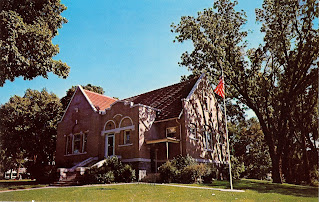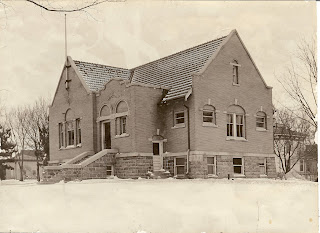 Anyone
who grew up in Algona from 1905 to 1982 was very familiar with the Algona
Public Library building. To me it was a
special place I frequented often. Mom
would often drop me off while she did her weekly grocery shopping so I could
check out what was new in the children’s department. I participated in the summer reading
programs, shyly sharing the story with Audrey Duncan or one of her helpers in
order to get credit for the number of books required to get a prize at the end
of the program. As I got older, I would
spend many hours there researching school papers and reading the latest
novels. The Carnegie was truly a magical
place. But how did it come to be?
Anyone
who grew up in Algona from 1905 to 1982 was very familiar with the Algona
Public Library building. To me it was a
special place I frequented often. Mom
would often drop me off while she did her weekly grocery shopping so I could
check out what was new in the children’s department. I participated in the summer reading
programs, shyly sharing the story with Audrey Duncan or one of her helpers in
order to get credit for the number of books required to get a prize at the end
of the program. As I got older, I would
spend many hours there researching school papers and reading the latest
novels. The Carnegie was truly a magical
place. But how did it come to be? THE DREAM
A
free public library had been a dream of local Algona citizens—especially women’s
groups—for many years. From the very
earliest days of the settlement, the locals had gathered for regular meetings
of the reading club. The local chapter
of the Women’s Christian Temperance Union held a banquet in April of 1889 to
raise funds to support the public “Reading Room” that they had recently
opened. People from all over the area
contributed books to build the inventory.
Volunteers took turns at three-month terms serving as “librarian.” The Reading Room would be open each Saturday
afternoon and evening.
Within
several months a Reading Room Association was formed which then led to a
reorganization in 1893 with the formation of the “Algona Library Association.” Its constitution read, “to serve the cause of progress by stimulating a love for good
literature, and by building up and maintaining in our midst a center of such
literature, and for the encouragement of all objects which tend to promote the
higher interests of our community, and for the maintaining of a public reading
room so far as practicable.”
LIBRARY GOAL
A
separate organization was formed in 1894 called the Public Library Association
whose main goal was to establish a public library. The group sold stock in the corporation and
anyone who purchased $10 worth of stock was entitled to free use of the
library. All students were allowed to use the books at no charge. It was at this time that the Algona Library
Association turned over their book collection, reorganized into the Women’s
Library Aid Society, and pledged their assistance in creating a public library.
The Algona Monday Club also loaned their choice collection of 600 volumes to
build the inventory of the Public Library Association.
 |
| Library in G.A.R. building - notice Capt. Ingham's tarpon on the wall |
In
June of 1897 the library association approached the city council asking that a
statute regarding the establishment of a public library be put to a vote of the
public. That year the referendum failed,
but the next year it was adopted and on December 31, 1898, all of the property
of the Public Library Association was turned over to the city and the Algona
Free Public Library opened on January 3, 1899 on the main floor of the G.A.R.
building.
ANDREW CARNEGIE’S GIFT
Andrew
Carnegie was a multimillionaire and philanthropist from New York City. He was a promotor of education and he came up
with the idea of offering grants to towns to be used for the building of a
library. Over 1600 Carnegie funded
libraries were built across the nation between 1886 and 1917, including many in
Iowa.
In
the early months of 1903, the library committee prepared and submitted an
application for a Carnegie funded library.
By borrowing a copy of the application completed with regard to the Carnegie
Library in Spencer, Iowa, they were able to present the information requested
by Andrew Carnegie with their initial application. They were pleased to receive a response
within 30 days bearing the good news of a $10,000 award if a suitable site
could be found.
THE SITE
 |
| See Ingham house in background |
Capt.
Wm. H. Ingham had earlier pledged the north half of the block on which his residence
was located if $25,000 could be raised for the erection of the library
building. Various fundraising attempts
were made. Citizens were able to raise very little additional funds to
add to the building fund, but Capt. Ingham did relent (perhaps with some nudges from his wife,
Caroline, who was one of the initial founders of the local chapter of the
W.C.T.U. and a lifelong promoter of reading and literature). He eventually donated the portion of the block on which the Carnegie Library was built.
With
a $10,000 grant from Andrew Carnegie and a suitable location obtained, the
library building committee hired Patten & Miller of Chicago as architects
to design the edifice. Bids were let and
four were received. The board met in
late July of 1904 and worked well into the night considering the bids. Local contractor A. M. Coan submitted the
lowest bid at $7,780 and received the contract which was to be completed by
December 15th. The agreement covered
everything except sewer, heating, plumbing, ventilation, electric wiring and
fixtures, window shades, and furniture.
After including these costs, the library building committee knew they
would be able to complete the building for slightly more than $10,000.
THE BUILDING COMPLETED
Designed
in Gothic style, the exterior was considered extremely plain compared to other
Carnegie libraries. The exterior size is
45 by 52 feet. The level just above the
foundation is of dark red pressed brick and the upper part of the building a
Roman brick of grey color from Omaha.
This brick was long and narrow which was popular at the time. It also contains Bedford stone caps and a gabled
red-tiled roof with copper gutters, downspouts and valleys. Glass doors at the top of a grand staircase on
the north opened to a tiled vestibule.
The
main story had a reading room and a children’s room, each 21 by 23 feet, with
the stackroom and lavatory located on the west side. Book shelves lined all the walls and the
children’s room featured a fireplace. The
librarian’s desk was located in the center to be able to keep an eye on all
areas. Large arches connected each room and
the walls and ceilings were artistically decorated. The desk and all trim were in golden oak,
with a rubbed finish.
 |
| Reading room |
 |
| North side children's room |
 |
| Librarian's desk and stackroom |
Broad
oak stairways and a side entrance half way down led to the well-lighted
basement which featured a ten-foot ceiling to be used as an assembly room large
enough to seat 150-200 people. It
contained a stage and fireplace. A fuel
room, two toilet rooms and a rest room would also be located on the lower
floor.
The
March 30, 1905 edition of the Algona Advance celebrated the opening of the new
library with the following description of the interior. “The
whole interior of the new home is handsomely finished and constructed with
artistic beauty. The entry ways, the
halls, the arches, the alcoves and the cozy nooks and corners all have a
pleasing and restful appearance. The
great amount of available room was a surprise to all, and that condition
elicited many favorable expressions from the visitors. The arrangement of the rooms and the
equipment is a gratifying feature of the construction.
The northeast room
presents a classic appearance and makes one feel as if in the presence of
higher qualities. The children’s room in
the southeast corner is truly a lovely home where the children can come to
store their minds with useful information.
On its walls hang the portrait of the venerable librarian, Rev. E. P.
McElroy, whose love for the children in his lifetime is well known, and the oil
painting landscape, Des Moines, river scene, donated by Will Purvis of
Chicago. The other departments are also
cheerful in appearance and designed for conveniences.”
The
building served the community for almost 80 years as a library before it was no
longer big enough for the needs of the area. It is a well-recognized
landmark in Algona which brings back many happy memories to those who spent any
time within its walls.
Copies can be purchased at the library, Chamber of Commerce, City Hall or from any KCGS board member. If you would like a copy mailed to you, send a check for $20 ($15 plus $5 postage) to KCGS, c/o Algona Public Library, 210 North Phillips Street, Algona, IA 50511. There are a limited number of calendars available so get yours soon before they are all gone.
OWN A PIECE OF HISTORY
A capital campaign is currently underway for a much needed renovation of the present library building located at 210 North Phillips in Algona. To assist in that effort, the Kossuth County Genealogical Society is selling a 2019 keepsake calendar tracing the entire history of the Algona Public Library from its beginning as a reading club in 1857 through its irreplaceable presence in the community today. The calendar is filled with photos, stories and tidbits that not only tell the library's story but will have you reminiscing about your youth. All profits from calendar sales go to the renovation project and at just $15 each, everyone can afford a copy or two (hint, hint--they make wonderful gifts!).Copies can be purchased at the library, Chamber of Commerce, City Hall or from any KCGS board member. If you would like a copy mailed to you, send a check for $20 ($15 plus $5 postage) to KCGS, c/o Algona Public Library, 210 North Phillips Street, Algona, IA 50511. There are a limited number of calendars available so get yours soon before they are all gone.
Until
next time,
Jean
If you enjoyed this
post, please don’t forget to “like” and SHARE to Facebook. Not a Facebook
user? Sign up with your email address in the box on the right to have
each post sent directly to you.
Be sure to visit the
KCHB Facebook page for more interesting info about the history of Kossuth
County, Iowa.
Reminder: The posts on Kossuth County History Buff are ©2015-18 by
Jean Kramer. Please use the FB “share” feature instead of
cutting/pasting.
